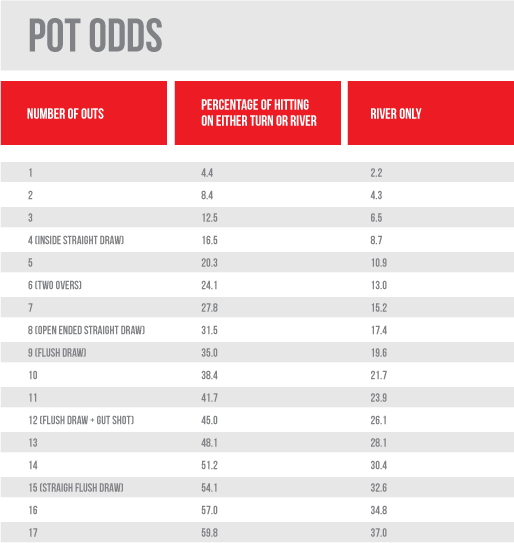You need to compare your equity (% chance to win the hand) vs pot odds (the ratio of how much you need to pay vs how much you stand to win). For example, everyone at the table calls to me in the SB with like Q7 off, so I call, because well, pot odds of 8-1. If the pot has 80 chips in it and you need to pay 10 to see it, then yeah you have 8:1. Understanding Pot Odds and Pot Equity. Pot Odds are the ratio between the size of the pot and the size of the bet faced by the player. E.g., if there is ₹100 in the pot and your opponent bets ₹20, you will have to bet one-fifth of the pot in order to get the chance of winning it.
Devs,
Have you considered adding pot odds & hand equity to the HUD that can be used in game, like in Holdem Indicator?
No, I don’t think it’s something we’re going to do. Yes, we did discuss it. That’s a different customer base though then what this tool is developed for.
Ty for the suggestion. We do have a free pot odds and outs tool if you’re interested. It’s pretty easy to learn. You learn and understand it once, you really don’t need the overlay imho.
The one thing I miss most from using that is the mucked showdown hand display. You didn’t have to open up and wait on BOL’s laggy hand replayer to see what your opponent had. Is that something DriveHUD would be capable of displaying somewhere on the table?
There’s a free odds and outs trainer and equity calc w/ this app:
One of the first and most important examples of 'poker math' that new no-limit hold'em players need to learn is how to calculate 'pot odds.' In fact, when people talk about the 'math of poker,' a lot of the time they are mostly referring to pot odds and how an understanding of them can help you decide whether to bet, raise, call, or fold.
Put most simply, pot odds represents the ratio between what you stand to gain in a hand of poker and what you have to spend in order to get it — that is, the ratio between your reward and your risk when making any given decision during a poker hand.
Calculating Pot Odds
For example, if there is $80 in the pot and your opponent bets $20, that makes a total of $100 in the middle. That $100 is the reward you can get if you're willing to risk $20 to call the bet. Pot odds are expressed as a ratio (reward-to-risk). In this case you're having to risk $20 to win $100, so your pot odds are 100-to-20, or 5-to-1.
That's the scenario poker players most often describe when talking about pot odds — that is, when facing a bet and deciding whether or not to call or fold. You add the amount of the bet to what is already in the pot to calculate the reward, the bet you need to call represents the risk, and the pot odds 'being given' to call is that reward-to-risk ratio.
Of course, you can also talk about pot odds after a player raises. Say you decide not just to call that $20 bet described above, but to raise to $80. That would mean your opponent has to call $60 to have a chance at winning what is now $180 in the middle — 180-to-60 or 3-to-1 pot odds.
That might seem simple enough — a little bit of addition and an easy division problem, and you can calculate pot odds.
But why bother? There are lots of reasons.
One big reason why you want to stay generally aware of what your pot odds are — which means keeping track of how big the pot is at all times and being able to compare the pot size to each bet — is that doing so helps you estimate whether or not the pot odds being offered to you are favorable or unfavorable given the situation.
Let's look at three common circumstances in no-limit hold'em in which pot odds can be helpful when making decisions.
Using Pot Odds When Playing a Drawing Hand

Say you are on a flush draw and have with the board showing . There is $120 in the pot, and your opponent has bet $60. You could call to see the river card, but are the pot odds favorable enough for you to make the call?
It's easy enough to see that the reward is $180 ($120 in the pot plus the $60 bet), and so with a $60 risk you are getting 180-to-60 or 3-to-1 pot odds. Is that good or bad?
You believe you probably have to make a flush in order to make a better hand than your opponent's, so that means you have nine outs — the nine remaining clubs — to make your hand. You can see six cards (the two in your hand plus the four on the board), leaving 46 unknown cards, so you can estimate your chance of seeing a club fall on the river to be 9 out of 46, or just over 4-to-1 against.
Compare your pot odds (3-to-1 to call) to the odds you'll make your flush (a little worse than 4-to-1 against). It's clear that calling isn't such a good choice — that the pot odds aren't favorable for calling — because over the long term calling is not a profitable play.
Let's say you were to make this call 100 times. About 20 times you'd make your flush on the river (actually a little less, but we'll round it up). You'd be risking $60 x 100 or $6,000. But your reward would only be $180 x 20 or $3,600. After making this call 100 times and winning only 20 hands, you'd have lost $2,400! (Note: we aren't considering what extra money might be won or lost after the river card, but just the profitability of this particular turn call.)
Pot odds are favorable when they are greater than the odds against making your hand. If the pot odds were 5-to-1 here, it would be a good call with it being just over 4-to-1 against making the flush. But 3-to-1 pot odds are unfavorable when drawing one card to make a flush.

Using Pot Odds to Decide Whether to Call a Preflop Raise
Pot odds can also be compared not just to a specific probability (like drawing to a flush), but also to a more general estimate of your chances in a hand.
Say for example you're playing $1/$2 no-limit hold'em and get dealt in the big blind. A player raises to $7 from the button and it folds to you.
First off... what are your pot odds here? There is $10 in the middle (the $1 small blind + the $2 big blind + the $7 raise), and you have to call $5 to stay in the hand. That's 2-to-1 pot odds.
Now, think about the prospect of playing out of position. It's a hand without a lot of potential that is almost certainly worse than whatever the player on the button who raised has. Unless you flop a couple of diamonds or perhaps trips or two pair, you're not likely to feel good about going very far with this hand. Are these 2-to-1 odds favorable?
No, they aren't. You could quantify this perhaps, noting how you with two suited cards you flop a flush draw about 11% of the time, you flop two pair about 2% of the time, and you flop trips about 1.3% of the time — that adds up to around 14% good flops, meaning it's worse than 6-to-1 against your seeing a good flop. That's just an estimate, really, but is obviously way worse than the 2-to-1 pot odds, so folding is in order.
What if a player raises to $7 from early position and five other players including the small blind call before the action reaches you in the big blind with your ? Now there's $44 in the middle and you have to pay $5 to see the flop. Those are almost 8-to-1 pot odds, which are in fact greater than the odds against your flopping something good — you might consider calling.
Using Pot Odds to Decide Whether to Call a Suspected Bluff
Pot odds can also be relevant when deciding whether or not to call what you think might be an opponent's bluff.
You've reached the river with your and the board shows . Your opponent raised before the flop and you called, and you called his bets on both the flop and turn. Now there's $100 in the middle and he's betting $50, giving you 3-to-1 pot odds to call.
You suspect strongly he could be bluffing, but you think it's possible he might have something like aces, kings, jacks, ace-queen, or king-queen and have you beat. While it's not feasible to calculate exactly the likelihood he's bluffing, you might be able to make a rough estimate — say, that he's probably bluffing at least a third of the time here.
That would make it 2-to-1 against your tens being best, making 3-to-1 pot odds favorable for you — a profitable call to make.
Conclusion
There are many other applications of pot odds in no-limit hold'em, but you can't take advantage of them until you start to become comfortable figuring out pot odds as a hand is playing out.
This is often easier to do when playing online poker, where the betting amounts and pot sizes are shown as numbers. But even when playing live, you can with practice become increasingly at ease keeping track of what's in the pot and calculating pot odds until it becomes second nature to you.
Poker Equity Pot Odds
And once you do, you can then use pot odds to help direct your decision-making in a variety of contexts.
Also in this series...
Ready to take a seat at the table? Put these hold'em tips into practice at PokerStars.
Want to stay atop all the latest in the poker world? If so, make sure to get PokerNews updates on your social media outlets. Follow us on Twitter and find us on both Facebook and Google+!
Pot Odds Poker Probability
Tags
cash game strategytournament strategyno-limit hold’embeginner strategypot oddsmathpreflop strategypostflop strategyoutsdrawing handsbluffingRelated Room
Full Tilt